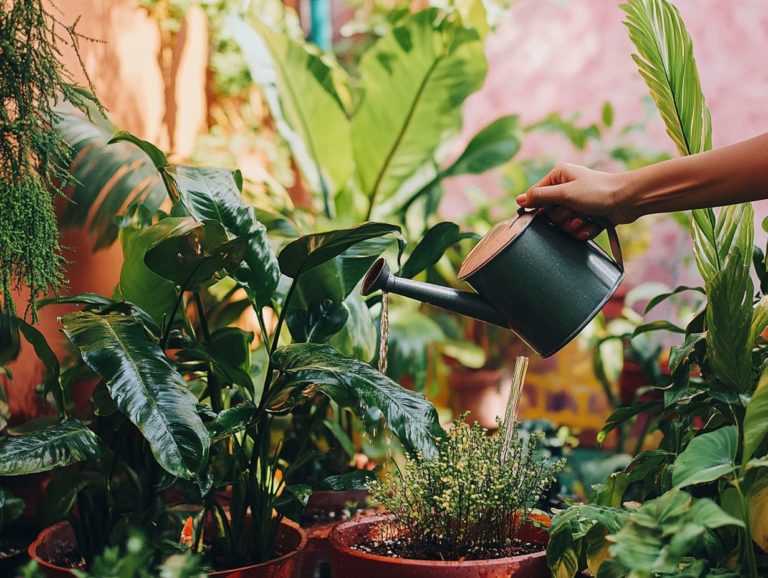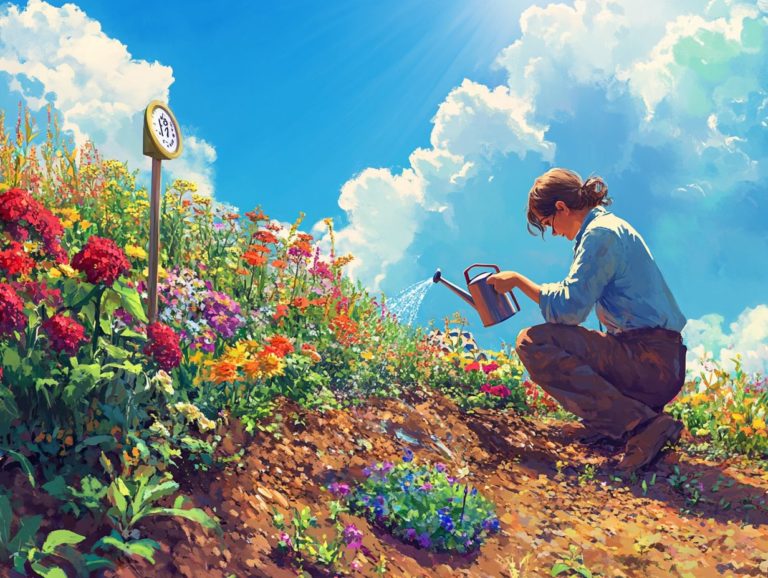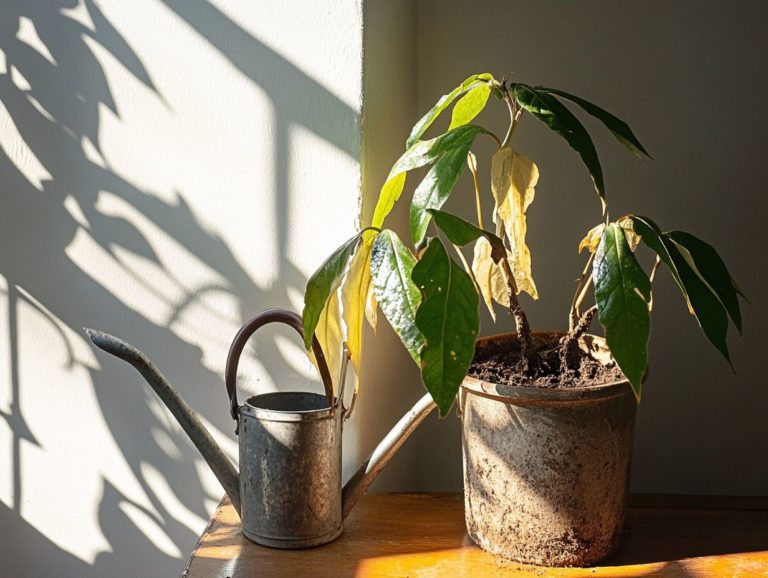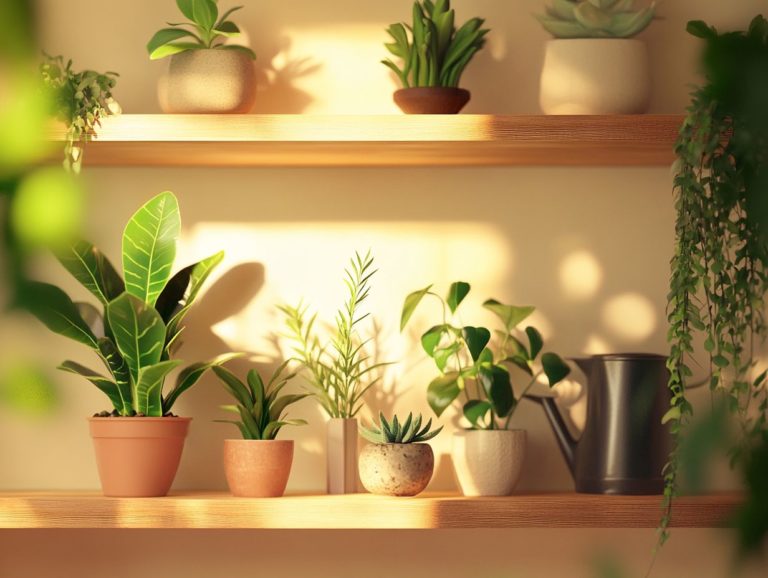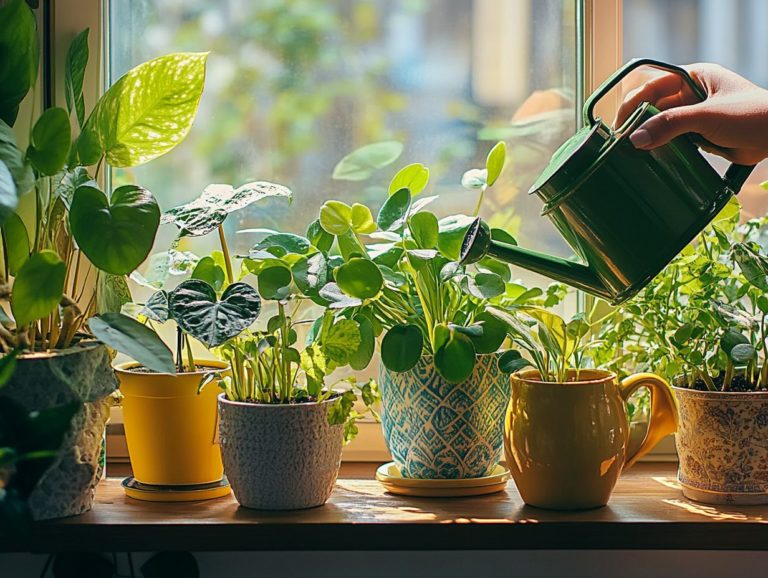5 Plants That Require Less Frequent Watering
Are you weary of the relentless care that traditional houseplants demand? Well, you re in for a treat!
Get ready to explore five amazing plants that thrive on little water! This article covers remarkable plants perfect for your busy lifestyle or for those just dipping their toes into gardening.
From the tenacious Snake Plant to the delightful Jade Plant, each of these selections enhances your home s aesthetic and brings unique benefits.
You ll uncover valuable tips on ideal growing conditions, common watering missteps, and inventive ways to weave these low-water wonders into your decor. Prepare to elevate your space with greenery that strikes the perfect balance between low-maintenance and high-impact!
Contents
- Key Takeaways:
- 1. Snake Plant
- 2. Aloe Vera
- 3. ZZ Plant
- 4. Jade Plant
- 5. Succulents
- How Often Should These Plants Be Watered?
- What Are the Best Conditions for These Plants to Thrive?
- What Are the Benefits of Having These Low-Water Plants?
- What Are Some Common Mistakes to Avoid When Watering These Plants?
- How Can These Plants Be Incorporated into Home Decor?
- Frequently Asked Questions
Key Takeaways:
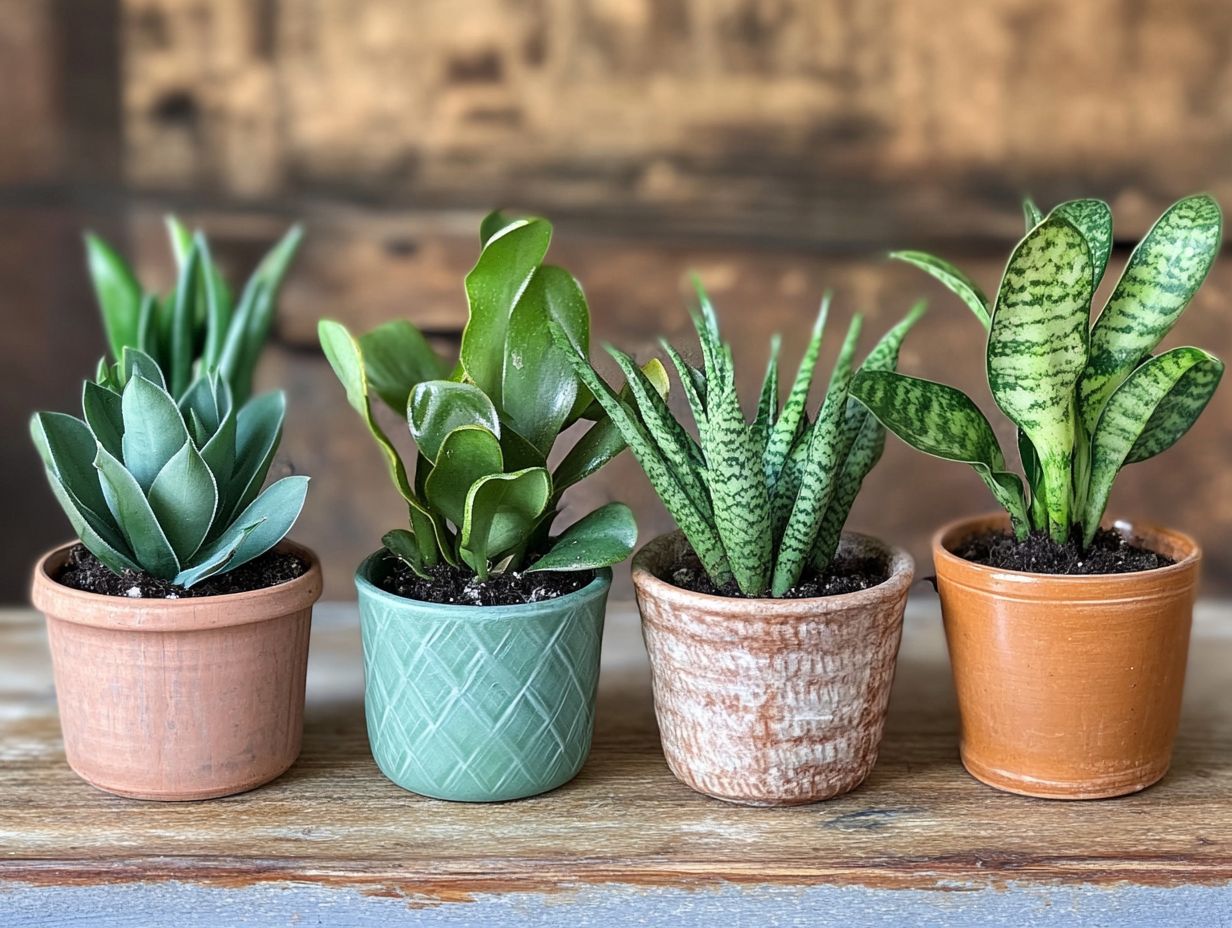
- The Snake Plant, Aloe Vera, ZZ Plant, Jade Plant, and Succulents need little water and require less frequent watering.
- These plants thrive when watered only when the soil is dry, kept in well-draining soil, and placed in bright, indirect sunlight.
- Having these low-water plants in your home can save on water, reduce maintenance, and effortlessly add greenery to your space.
1. Snake Plant
The Snake Plant, also known as Sansevieria, is a popular houseplant. Its striking look and resilience make it ideal for both beginners and experienced plant lovers.
This plant thrives in various lighting conditions, especially low light, making it easy to incorporate into any home decor.
Characterized by its tall, architectural leaves, the Snake Plant adds a sculptural touch to any space, drawing the eye upward and creating an illusion of height.
But it s not just a pretty face; this plant is celebrated for its air-purifying capabilities, actively absorbing toxins and enhancing indoor air quality.
To keep this hardy companion thriving, water it every 2 to 6 weeks, ensuring the soil dries out completely between waterings.
The Snake Plant adapts effortlessly to different lighting, thriving in anything from indirect light to bright conditions, proving to be quite forgiving.
Incorporating it into your home decor is simple. Whether it’s nestled in a corner, perched on a shelf, or taking center stage on a coffee table, it complements various styles, from modern minimalism to bohemian chic.
2. Aloe Vera
Aloe Vera is a succulent that you ll come to appreciate for its medicinal properties and effortless care. It s perfect for anyone looking to blend beauty with functionality in their living space.
This plant needs little water and flourishes in bright light, making it a great companion for those who might forget to water their greenery.
Not only does Aloe Vera offer health benefits like soothing burns and hydrating skin, but it also acts as a natural air purifier, significantly improving indoor air quality.
When caring for this resilient plant, provide well-draining soil and plenty of sunlight to prevent a condition where roots decay due to excess moisture.
Water sparingly, allowing the soil to dry out between waterings; usually, this means giving it a drink every two to three weeks.
Keep an eye out for pesky invaders like mealybugs and aphids, which can negatively impact the plant’s health if ignored.
With proper care, you can ensure this remarkable succulent thrives, making it a valuable and attractive addition to your home.
Don t wait to transform your space with these incredible low-water plants!
3. ZZ Plant
The ZZ Plant, or Zamioculcas zamiifolia, is a gem celebrated for its stunning glossy leaves and impressive ability to thrive in low-light conditions. It s the ideal choice for anyone seeking a low-maintenance indoor companion.
Its drought-tolerant nature means even if you occasionally forget to water, you can enjoy its beauty without guilt. This resilient plant also purifies the air, removing toxins and fostering a healthier living space.
To ensure it thrives, aim for bright, indirect light, although it can happily reside in shaded corners too. Be careful to avoid overwatering; it s crucial for your plant’s health!
Letting the soil dry out between watering sessions is key to preventing root rot. Keep an eye out for common issues like yellowing leaves, which usually signal overwatering, and pest invasions, both of which can be easily managed with the right attention.
With just a touch of care, you’ll enjoy the ZZ Plant’s captivating charm for years to come. Bring home a ZZ Plant today and transform your space!
4. Jade Plant
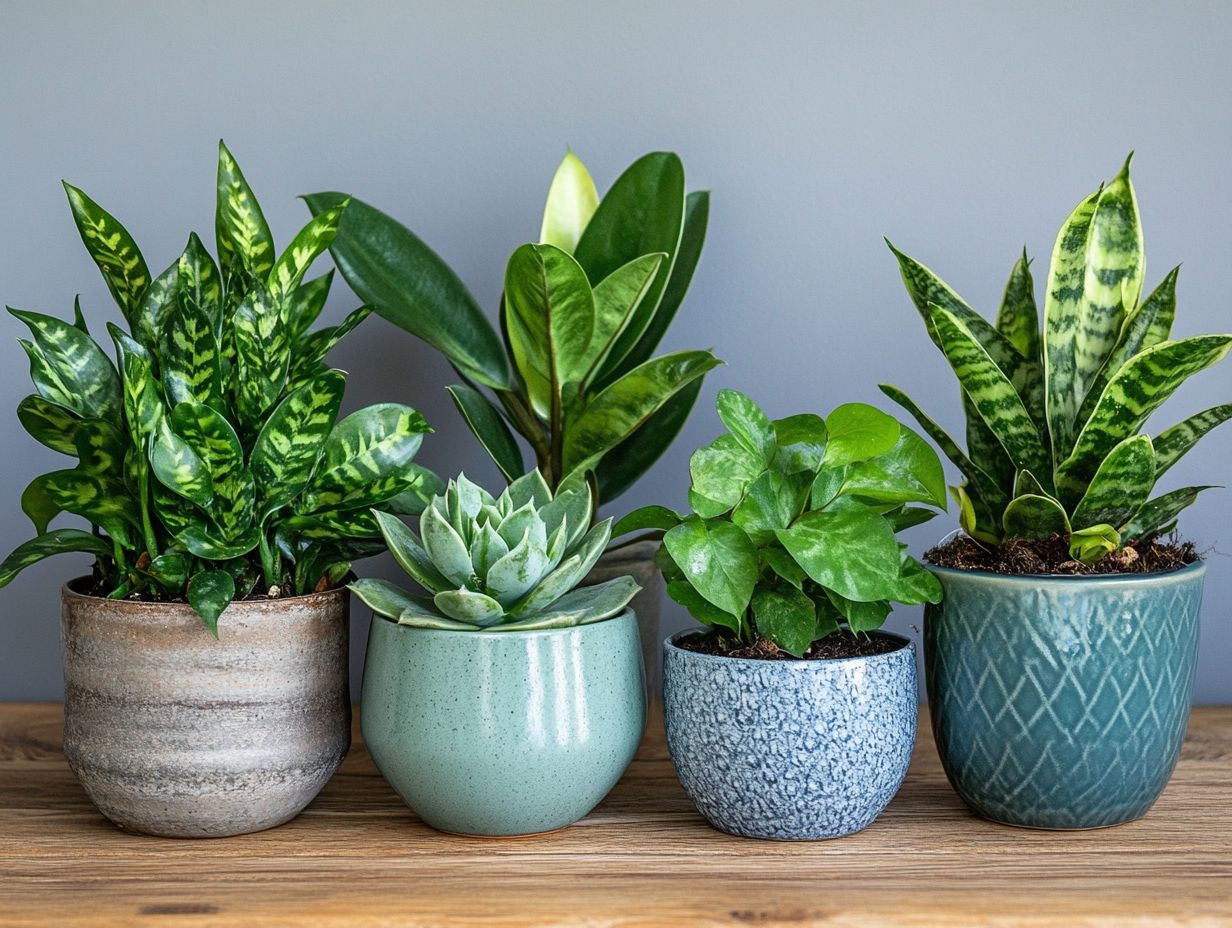
The Jade Plant, known scientifically as Crassula ovata, is more than just a succulent; it s a symbol of good luck and prosperity, making it a standout choice for your home decor.
With its thick, fleshy leaves and minimal water needs, it’s perfect for those who appreciate easy-care houseplants that thrive in bright light and forgive the occasional neglect.
Hailing from southern Africa, this resilient plant carries cultural weight in various traditions, especially in Asian cultures where it s cherished as a Feng Shui element aimed at creating harmony in living spaces and drawing in financial success.
To nurture a flourishing Jade Plant, prioritize sunlight, as it absolutely loves bright, indirect light. Watering requires a thorough soak followed by a dry spell; overwatering can lead to root rot.
Regularly checking the soil s dryness will help maintain its health and vibrancy, making it a simple yet rewarding addition to your home. Choose a Jade Plant today to enhance your space!
5. Succulents
Succulents are a captivating collection of houseplants that you ll likely fall in love with for their unique shapes, vibrant colors, and extraordinary ability to store water.
They make an excellent choice for anyone looking to grow low-maintenance indoor plants. These drought-tolerant wonders thrive in various settings, demanding minimal water and care, which is a blessing for those who occasionally forget to water.
With countless varieties at your fingertips, you might be drawn to popular choices like the whimsical String of Pearls, with its delightful cascading beads, or the striking Burros Tail, known for its long, trailing stems.
Don’t overlook the Sago Palm either; it stands out with its dramatic fronds, adding an intriguing tropical flair to your space. To keep these beauties thriving, it s essential to grasp their specific light needs; most prefer bright, indirect sunlight.
When watering, exercise caution allowing the soil to dry out between waterings will help prevent over-saturation, ensuring these resilient plants flourish beautifully in your home.
Adopt a succulent today and watch your indoor garden thrive!
How Often Should These Plants Be Watered?
Understanding how often to water your houseplants is essential for their health, particularly for indoor favorites like Snake Plants, ZZ Plants, and succulents, which are celebrated for their drought-tolerant nature.
Overwatering can lead to root rot, while neglecting to water can result in wilting. It s crucial to strike a balance that allows these easy-care houseplants to thrive without the threat of neglect.
Each plant species has its own unique watering requirements, influenced by factors like light exposure and the changing seasons.
For instance, during sunnier months, your succulents might crave more frequent watering; whereas in winter, their growth slows down, and they will need less hydration.
To ensure you’re providing optimal moisture levels, simply check the soil by inserting your finger about an inch deep. If it feels dry, it s time to water.
However, if it s still damp, hold off for a few more days. By paying attention to these details, you not only avoid the pitfalls of over or under-watering but also enhance the overall health and vibrancy of your indoor oasis.
What Are the Best Conditions for These Plants to Thrive?
To help houseplants like Snake Plants, Aloe Vera, and ZZ Plants thrive, understand their unique needs. Focus on light, temperature, and humidity. These low-maintenance beauties generally prefer bright light but are surprisingly adaptable. They can tolerate lower light levels, making them perfect for various indoor spaces.
For optimal growth, choose a location with indirect sunlight, especially in warmer climates. These plants thrive in cooler temperatures ranging from 60 F to 75 F. Humidity doesn t need to be extravagant; a comfortable range of 30% to 50% will do just fine.
When placing these plants, consider positioning them near windows or in well-lit corners. However, be cautious of direct sunlight, as it can scorch their delicate leaves. Grouping them together can create a small area with higher humidity, promoting better growth and overall health for these resilient companions.
What Are the Benefits of Having These Low-Water Plants?
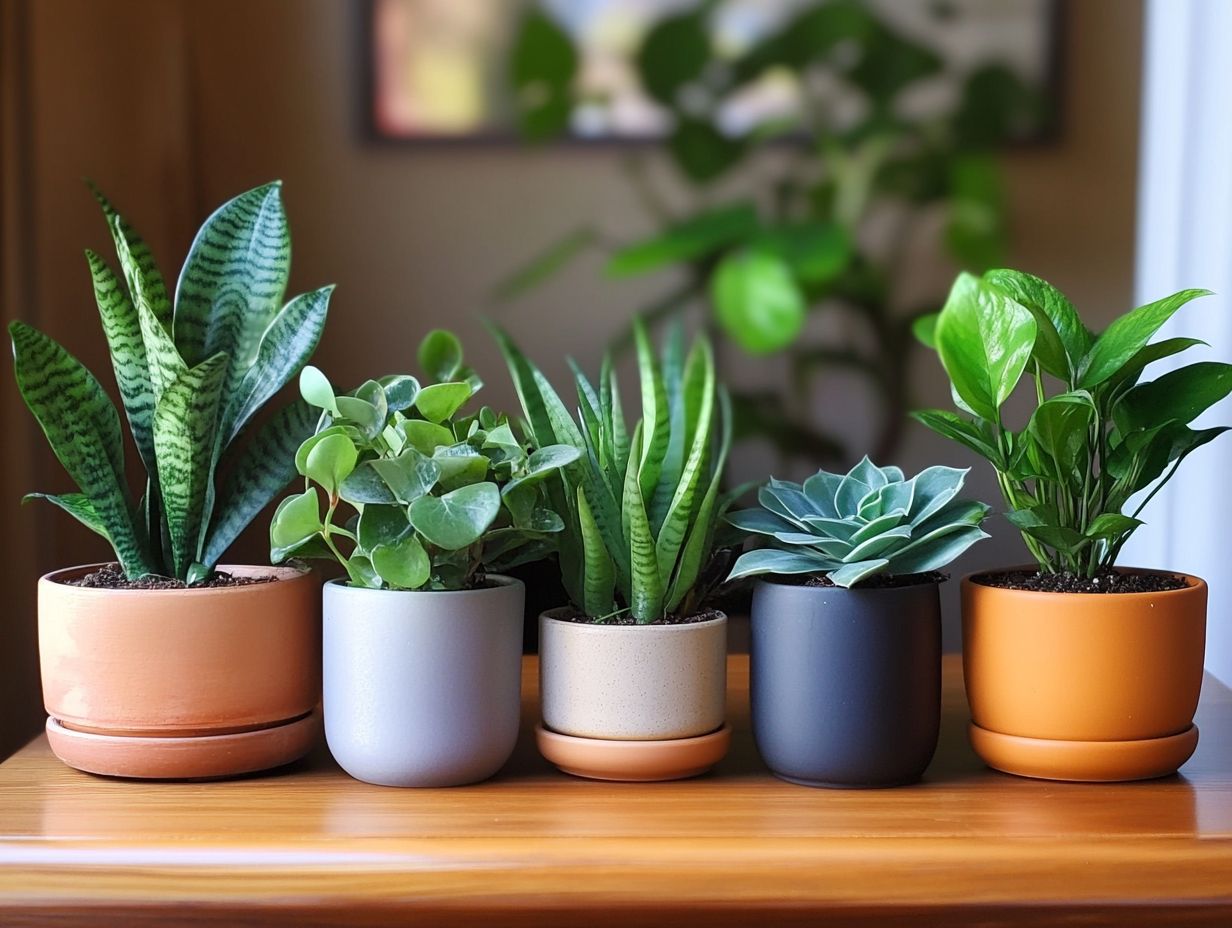
Adding low-water plants like succulents, ZZ Plants, and Snake Plants to your home offers many benefits. These plants don t just look good; they improve your indoor air quality!
They require minimal care and significantly enhance your indoor air quality, transforming your living space into a healthier, more vibrant environment.
The natural air purification abilities of these plants filter out toxins, creating a fresher atmosphere that boosts your overall well-being. Their easy maintenance means even those with busy schedules can enjoy the perks of indoor greenery without extensive upkeep.
Surrounding yourself with these plants can also positively impact your mental health. Research suggests that interacting with nature can alleviate anxiety and foster a sense of calm. Just imagine a few strategically placed succulents on your windowsills or a Snake Plant tucked into a corner these simple touches can instantly elevate the mood of any room!
What Are Some Common Mistakes to Avoid When Watering These Plants?
Watering houseplants like succulents and ZZ Plants is essential for their well-being. However, many new plant owners make common mistakes that can hinder growth or, worse, lead to plant demise. By mastering the art of proper watering, you can significantly enhance both the longevity and beauty of your indoor greenery.
One frequent misstep is skipping the crucial step of checking soil moisture before watering. This oversight can drown roots or leave them parched. Cultivating the habit of feeling the top inch of soil is vital; if it feels dry, it’s time to water. Additionally, incorporating 7 indoor plants that love regular watering can help you better understand your watering needs. Remember, plants typically need less water during the cooler months.
By establishing a consistent routine while remaining attentive to the specific needs of each plant type, you re setting yourself up for success in maintaining their vibrancy and health.
How Can These Plants Be Incorporated into Home Decor?
Incorporating houseplants like Snake Plants, Aloe Vera, and succulents into your home decor can truly transform your living space! These vibrant additions enliven your surroundings and infuse a refreshing touch of nature that enhances the overall aesthetic.
To elevate the visual appeal, choose decorative pots that align with your interior style whether it s modern, rustic, or eclectic. Create arrangements by placing these plants on shelves, hanging them from the ceiling, or using plant stands to add layers and depth.
Mix different textures and types, such as pairing a tall Snake Plant with trailing Ivy, to create a lively contrast that naturally draws the eye.
For lasting beauty, monitor watering schedules, provide adequate sunlight, and occasionally dust the leaves. This attention to detail ensures your plants remain a vibrant and enduring part of your decor.
Frequently Asked Questions
What are 5 plants that require less frequent watering?
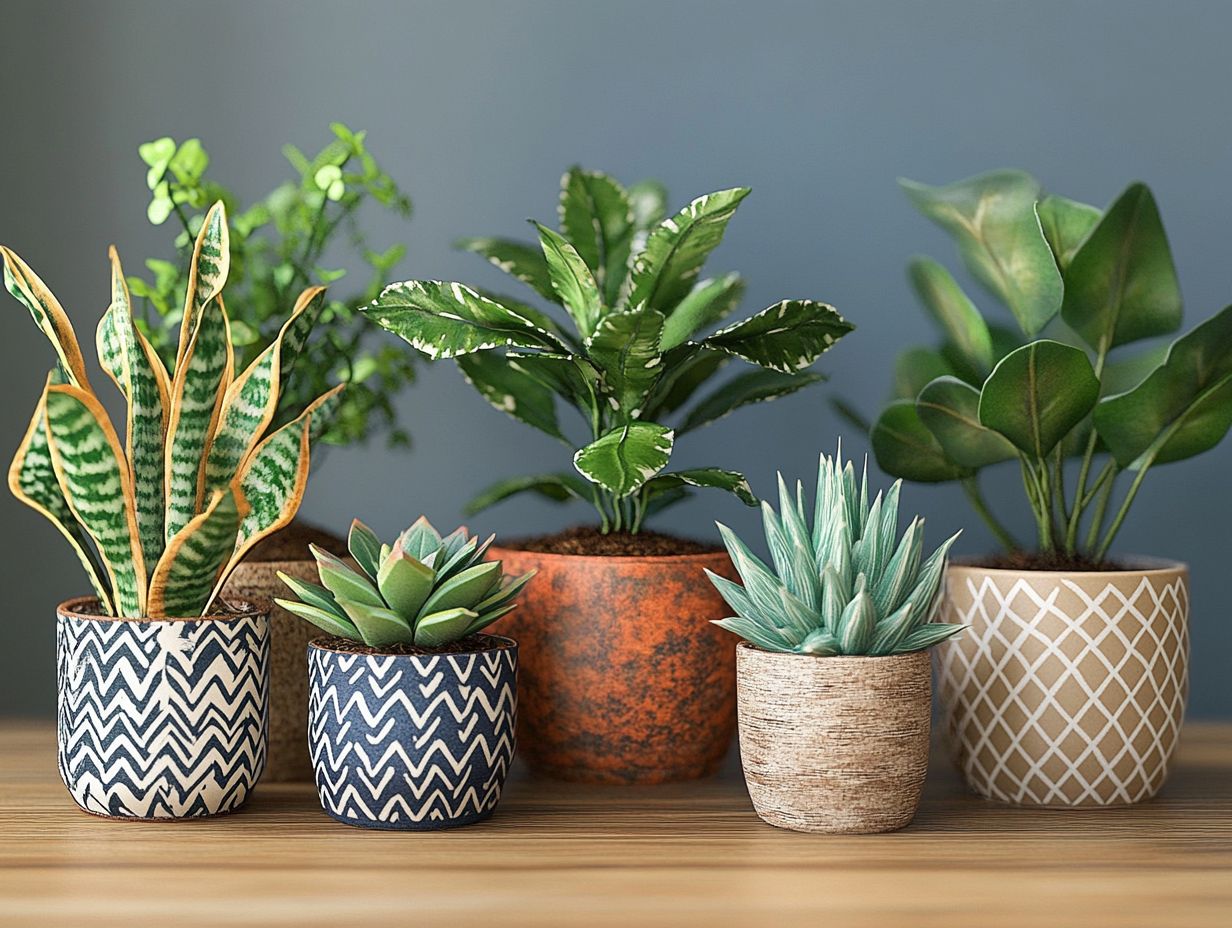
Five plants that need less frequent watering are snake plants, succulents, cacti, ZZ plants, and spider plants.
Why do these 5 plants require less frequent watering?
These plants have adapted to dry environments. They store water in their leaves and stems, allowing them to survive longer without water.
How often should I water these 5 plants?
How often you water depends on the plant type, temperature, humidity, and pot size. Generally, these plants can go 2-3 weeks without water.
Do these 5 plants require any special care?
These plants need proper care, including adequate sunlight, soil that drains well, and occasional fertilization. They thrive on attention but don t need much!
Can I overwater these 5 plants?
Yes! Overwatering can quickly lead to root rot and other issues. Always let the soil dry out completely before watering again, and avoid leaving water in the saucer.
Are these 5 plants suitable for beginners?
Absolutely! These plants are super easy to care for and are perfect for anyone with a busy lifestyle.

